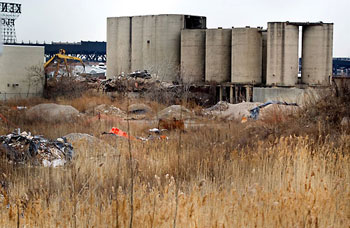Whole Foods Market
continues to innovate and model sustainable practices for the grocery industry
at its first store in Brooklyn, NY.
While Whole Foods
often opens dozens of stores a year, this one was 10 years in the making because
it first had to clean up the Superfund site it sits on. In some places,
contractors had to dig down some 15 feet to remove a century’s worth of
contaminated soil from its predecessors: an oil company, auto repair shop and a
lumber yard. It sits right on the infamous Gowanis canal, one of the most
polluted waterways in the nation. That too is about to get a $500 million
cleanup, which the EPA approved last year.
At last month’s grand opening, customers were treated to a 56,000 square foot store that incorporates the best of green building and renewable energy features – expected to achieve LEED Platinum certification.
Before:

After!

For the exterior,
Whole Foods reused 250,000 bricks from an old Newark, NJ building, and inside, wood
used for paneling and product displays comes from the nearby former Coney
Island boardwalk.
Really innovative and interesting, 19 LED street lights and two electric car charging stations produce more than twice the energy they consume and create micro-grid that will keep the power going during a blackout. Solar panels and a vertical axis wind turbine are built right into the streetlights, which also have a battery that stores energy for illumination at night.
NYC-based
Urban Green Energy, which makes the street lights and charging stations, points out that the off-grid street light save money because they don’t require expensive
trenching and wiring to be installed.
Also outdoors, the use of solar is hard to miss because solar canopies cover just about all of the parking lot. The 324 kilowatt (kW) array supplies a third of the store’s electricity.
In the bowels of the store is another innovation – a state-of-the-art carbon dioxide refrigeration system powered by a 157 kW combined heat and power (CHP) plant.
CHP heats the building and generates chilled water that will also keep the building functioning if grid-based power goes out. It captures and
then reuses waste heat that operates an absorption chiller which cools the store.
Deployed in only one other US
supermarket so far, carbon refrigeration cuts greenhouse gases about 30% by
eliminating carbon forcing HFC refrigerants.
Daylighting and high efficiency
lighting also keep energy demand low, and combined with an
extensive water recycling system, these technologies make the store
one of the most energy efficient supermarkets in the nation – using 60% less energy than required by building codes.
We saved the best for last. This Brooklyn store is the first supermarket to source its vegetables right from its roof! The 20,000 square foot commercial-scale
greenhouse
is owned by a local organic grower, Gotham Greens, which will grow produce
year-round and sell it to all nine Whole Foods stores in New York City.
Supporting Local Farmers
The greenhouse is a physical extension of
something Whole Foods has being doing behind the scenes – supporting local
farmers with low, fixed interest loans and mentoring help.
After giving out $10 million in loans (ranging from $1000 to $100,000), its “Local Producer Loan Program” just increased the target to $25 million.
Besides helping many businesses expand, the funds make pioneering projects possible in biodynamic farming, non-GMO animal feed, pollinator
health and sustainable packaging. For example, $100,000 enabled a vertical
farm near Chicago to expand, which supplies local Whole Foods stores there.
Whole Foods is one
of the largest corporate users of renewable energy and has a target
of cutting energy consumption 25% per square foot by 2015. One of its
Connecticut stores is the first supermarket to generate most of its power
on-site with fuel
cells.
Learn more about Whole Foods’ loan program:

There may be some token solar panels about the parking lot, but the store is a traditional suburban, car accommodation, box store, located in a pedestrian/biking focused city. The innovations suggested here are hardly tinkering around the edges in terms of reducing CO2 generating activity resulting from collection of grocery goods.
And if the power grid fails it may be do to a storm and the store may well be under water as the site was in 2012 when Sandy hit. Building in a coastal flood district is hardly forward-looking.